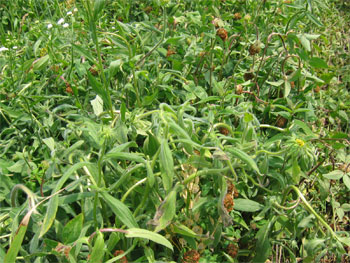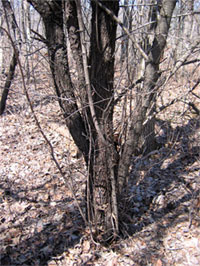Rosemount Wildlife Preserve
![[Photo: Woodland after burn to control invasives.]](/sites/default/files/shared/images/projects/rosemount_wildlife_preserve/woodland_after_burn.jpg)
The woodland area at Rosemount Wildlife Preserve after a burn to control invasive plants.
The Rosemount Wildlife Preserve illustrates Friends of the Mississippi Rivers comprehensive approach to protecting natural open space We have played a role in the envisioning, creation, and ongoing mangement of the site.
Site history
Located in the north-central part of Rosemount, the Wildlife Preserve is a 16-acre parcel that was donated to the city in 2006 by Ms Aina Wiklund. Prior to that donation, Ms Wiklund sought permanent protection for her entire 26-acre mostly woodland property. That was achieved in 2005, when the Minnesota Department of Natural Resources (DNR), the Dakota County Farmland and Natural Areas Program (FNAP), and the City of Rosemount teamed up to purchase a conservation easement for the property.
The site is located within the natural greenway corridor known as the Northern Dakota County Greenway. The Greenway identifies high quality natural areas that serve as corridors for native wildlife and flora. Most of the Wildlife Preserve was identified by the DNR as having high biodiversity significance, meaning the site retains very good natural features and plant communities, but is degraded somewhat by non-native invasive species.
FMR has been an active part of this project since its inception in 2001. We not only assisted in brokering the deal to protect the Wiklund property and the wildlife preserve, but we have led the effort to restore the property as well.
Management Plans
Although the Wildlife Preserve has different ownership of the two parcels, we will refer to the entire 26 acres as one site, as the planning and management have happened collaboratively on both parcels. In 2003, a prairie stewardship plan was developed for the site, which outlined specific tasks for restoring a 7-acre old field to native mesic prairie. In 2003, a second plan was developed to include management of the remaining 19 acres, most of which is oak woodland. Funders for the management plans included the DNR Prairie Stewardship Program, and the Dakota County FNAP.
Prairie restoration A unique approach
![[Photo: Old field before prairie restoration.]](/sites/default/files/shared/images/projects/rosemount_wildlife_preserve/old_field_before.jpg)
Old field before prairie restoration.
![[Photo: A cover crop on the prairie in the first year of restoration.]](/sites/default/files/shared/images/projects/rosemount_wildlife_preserve/prairie_year_1-cover_crop.jpg)
A cover crop on the prairie during the first year of restoration.
![[Photo: Dead red clover.]](/sites/default/files/shared/images/projects/rosemount_wildlife_preserve/dead_red_clover_after_spray.jpg)
After spraying, the red clover was killed off (brown areas), but natives survived.
The restoration of the preserve began in 2004 with the prairie restoration. Ms Wiklund prefers to avoid broadcasting of herbicides whenever possible, due to the negative impacts to wildlife and drinking water. Chemicals are typically used during the site preparation, prior to seeding. Preparation of an old field, which is dominated by non-native grasses and other species, generally follows a sequence of steps: mow, broadcast herbicide, burn, herbicide, till, harrow and seed. This process takes about one full growing season. To avoid chemicals, we tried an unusual method of site preparation involving repeated tilling throughout one growing season to disrupt the growth of the weeds. We seeded the site in fall 2004 with a mix of native prairie grasses and flowers. Straw mulch was applied and crimped into the soil to reduce soil erosion on the sloping terrain.
The first growing season in 2005 was typical, with an abundance of annual weeds. By the end of the season there were a few native species visible, but not what would normally be seen. Red clover, on the other hand, was very abundant and dominated the site. In 2006 the site looked like it had been seeded entirely with red clover. We decided that in order to save the restoration wed have to apply some herbicide. A dilute mixture of an herbicide that targets legumes (red clover is a legume, or pea family) was applied, causing the clover to wilt and die. The native plants then began to appear and by the end of the season Canada wild rye was abundant, along with a number of other native species. Our fingers remain crossed that the natives persist and flourish. A prescribed burn is planned for spring 2007.
Funding for the prairie restoration was provided by the DNR Metro Greenways, DNR Metro Conservation Corridors, and DNR Remediation Fund Grant.

The herbicide spraying of the red clover gave the native prairie plants a leg up. Now theyre thriving.
Oak woodland restoration
![[Photo: Woodland burn.]](/sites/default/files/shared/images/projects/rosemount_wildlife_preserve/woodland_burn-2006-11-09.jpg)
Controlled burns help control invasive plants and help natives, which are well-adapted to natural prairie fires, better compete for survival.
In 2005 and 2006 we tackled the woodland restoration, beginning with removal of massive amounts of common buckthorn the invasive, exotic shrub that displaces native woodland plants. Some of the shrubs were as much as 8 inches in diameter, and quite dense throughout. A crew began by cutting and burning the shrubs on 6 acres in winter 2005, and treating the cut stumps with herbicide to prevent resprouts. The area was burned the following fall. In spring 2006 the new growth was cut down and the site was burned again in fall 2006. The same process was applied to the other 10 acres of woodland, beginning one year later in late winter 2006. By using repeated mechanical control methods (burning and cutting), we hope to avoid or minimize chemical use. So far it has worked well, with about 80 percent reduction of buckthorn on the first removal project.
To replace the native shrub component of the woodland, FMR held a volunteer event in spring 2006 and will have another one in spring 2007. Volunteers install bare root trees and shrubs, then encircle small groups of plants with fencing to prevent deer browsing. In fall 2007 we will also install seed of native woodland flowers to try to bolster the sites plant diversity.

This buckthorn was an average specimen of the large buckthorn bushes that had invaded the woodland.
Funding for the woodland restoration has been provided by the Upper Mississippi River Forestry Partnerships Neotropical Migratory and Forest Bird Habitat Program, DNR Metro Conservation Corridors, DNR Remediation Fund Grant, Dakota County FNAP, Ms Wiklund, and SKB Environmental.
![[Photo: Brush crew]](/sites/default/files/shared/images/projects/rosemount_wildlife_preserve/brush_crew.jpg)
One of the brush crews that cut, stacked, and burned buckthorn in the woodland restoration. Stumps were treated with herbicide to prevent resprouting.
Photo ©